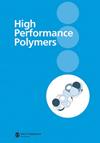不同成型压力对玻璃纤维/二硫化钼/聚四氟乙烯复合材料性能的影响
IF 1.6
4区 化学
Q3 POLYMER SCIENCE
引用次数: 0
摘要
玻璃纤维(GF)和二硫化钼(MoS2)都能提高PTFE基复合材料的综合性能,但成型压力对复合材料的性能有显著影响。在本研究中,在不同的成型压力(50–70 MPa)下制备了GF/MoS2/PTFE复合材料,并对其力学性能和摩擦学性能进行了评估。结果表明,摩擦学参数(如摩擦系数和体积磨损率)和机械参数(如密度、硬度、拉伸强度和断裂伸长率)随成型压力的变化而变化。当成型压力为50MPa时,GF/MoS2/PTFE复合材料表现出最佳的力学性能。复合材料具有最好的耐磨性,在60MPa的成型压力下,最低磨损率仅为2.135×10−6mm3/Nm,在70MPa的成型温度下,最低摩擦系数为0.166。SEM分析预测,用于制造样品的成型压力增加,将导致样品内部产生更大的残余应力,最终导致开裂和剥落。在摩擦试验中,成型压力较低的试样更有可能出现更深、更宽的表面沟槽,并脱落填充物。由于成型压力的增加,复合材料表面的沟槽深度和填料脱落也更加明显。本文章由计算机程序翻译,如有差异,请以英文原文为准。
Effect of different molding pressures on the properties of glass fiber / molybdenum disulfide / Polytetrafluoroethylene composites
Both glass fiber (GF) and molybdenum disulfide (MoS2) can enhance the comprehensive properties of PTFE (polytetrafluoroethylene)-based composites, however the properties of the composites are significantly influenced by the molding pressure utilized. In this study, GF/MoS2/PTFE composites were produced under varied molding pressures (50–70 MPa), and the composites’ mechanical and tribological properties were evaluated. The results showed that the tribological parameters (such as friction coefficient and volumetric wear rate) and mechanical parameters (such as density, hardness, tensile strength, and elongation at break) varied depending on the molding pressure. When the molding pressure was 50 MPa, the GF/MoS2/PTFE composites displayed their finest mechanical properties. The composite had the best wear resistance with the lowest wear rate of only of 2.135 × 10−6 mm3/Nm at a molding pressure of 60 MPa and the lowest friction coefficient of 0.166 at a molding pressure of 70 MPa. The increased molding pressure that was employed to make the samples, as predicted by SEM analysis, would lead to greater residual stresses inside the specimens, which would ultimately result in cracking and peeling. In the friction test, specimens with a lower forming pressure are more likely to have surface furrows that are deeper and wider, as well as to shed their filler. Due to the increased molding pressure, the depth of furrows and filler shedding on the composite surface are also more apparent.
求助全文
通过发布文献求助,成功后即可免费获取论文全文。
去求助
来源期刊

High Performance Polymers
化学-高分子科学
CiteScore
4.20
自引率
14.30%
发文量
106
审稿时长
1.2 months
期刊介绍:
Health Services Management Research (HSMR) is an authoritative international peer-reviewed journal which publishes theoretically and empirically rigorous research on questions of enduring interest to health-care organizations and systems throughout the world. Examining the real issues confronting health services management, it provides an independent view and cutting edge evidence-based research to guide policy-making and management decision-making. HSMR aims to be a forum serving an international community of academics and researchers on the one hand and healthcare managers, executives, policymakers and clinicians and all health professionals on the other. HSMR wants to make a substantial contribution to both research and managerial practice, with particular emphasis placed on publishing studies which offer actionable findings and on promoting knowledge mobilisation toward theoretical advances. All papers are expected to be of interest and relevance to an international audience. HSMR aims at enhance communication between academics and practitioners concerned with developing, implementing, and analysing health management issues, reforms and innovations primarily in European health systems and in all countries with developed health systems. Papers can report research undertaken in a single country, but they need to locate and explain their findings in an international context, and in international literature.
 求助内容:
求助内容: 应助结果提醒方式:
应助结果提醒方式:


